Halal Cosmetic Products Market Size
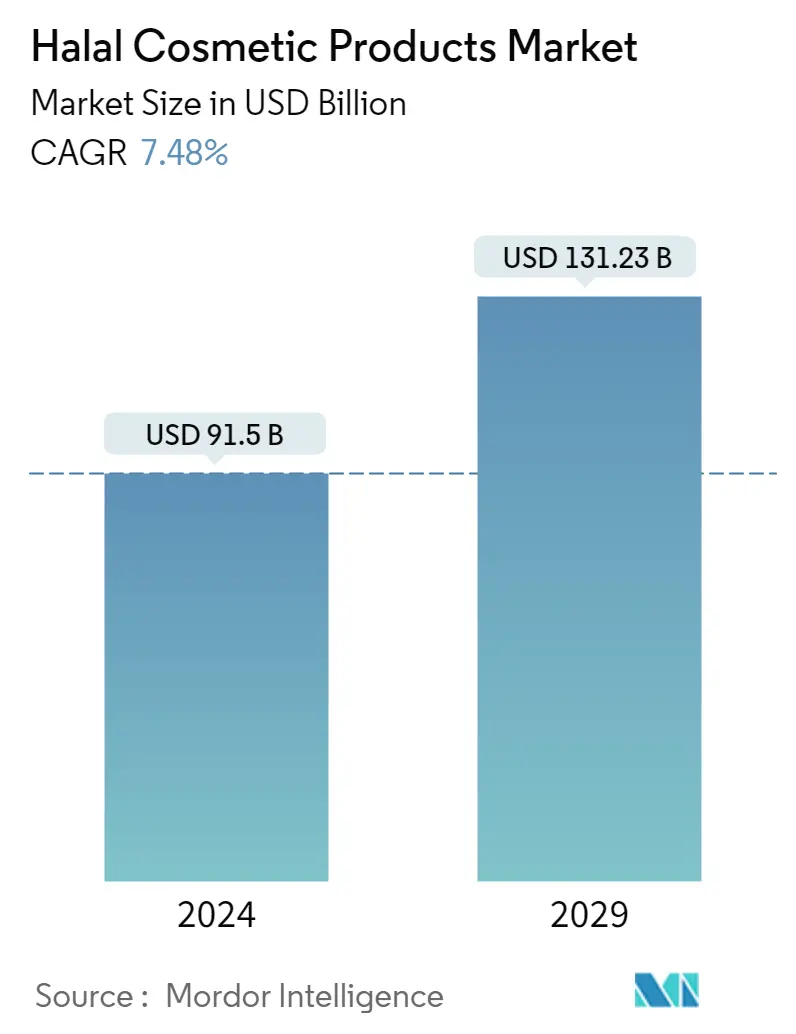
| Study Period | 2018 - 2029 |
| Market Size (2024) | USD 91.50 Billion |
| Market Size (2029) | USD 131.23 Billion |
| CAGR (2024 - 2029) | 7.48 % |
| Fastest Growing Market | Europe |
| Largest Market | Middle East and Africa |
Major Players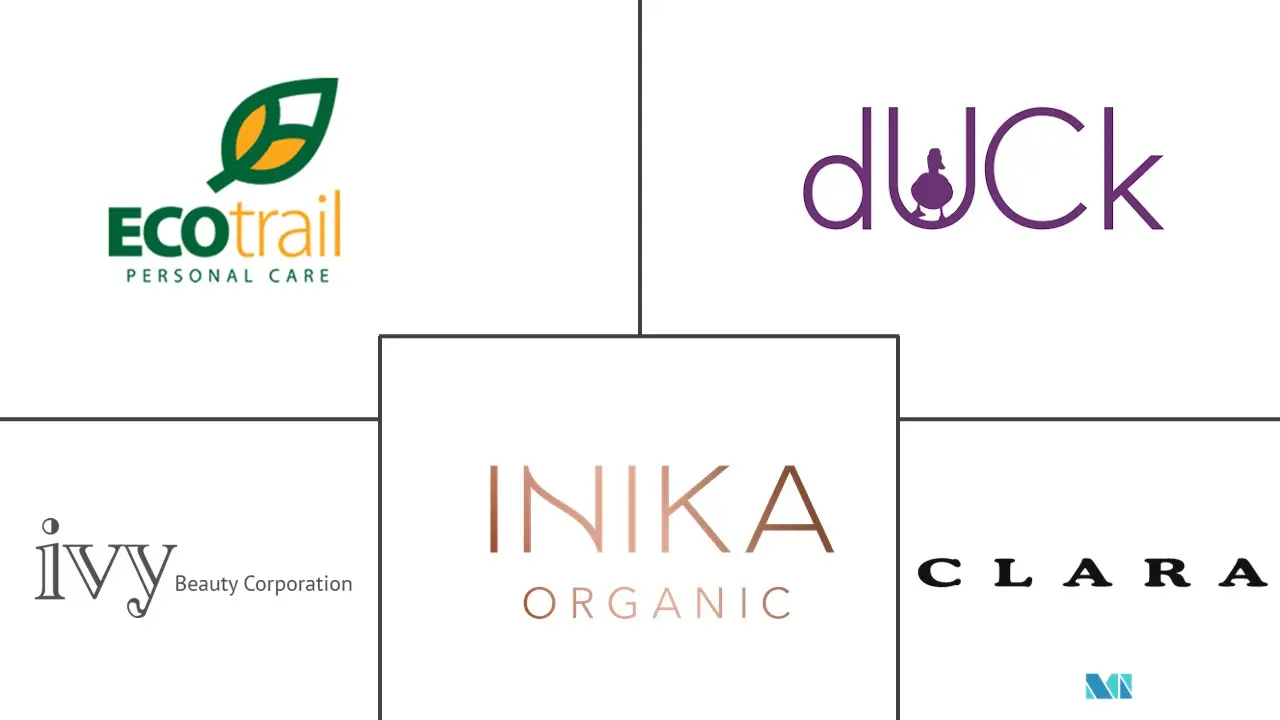
*Disclaimer: Major Players sorted in no particular order |
Halal Cosmetic Products Market Analysis
The Halal Cosmetic Products Market size is estimated at USD 91.5 billion in 2024, and is expected to reach USD 131.23 billion by 2029, growing at a CAGR of 7.48% during the forecast period (2024-2029).
The pandemic has created opportunities for new product lines such as creams, face creams, eye care, and sanitizers. The outbreak has modified consumer demand for above-the-mask products such as eye care, eye makeup, hand creams, face creams, and others. Most of the traditional markets across the globe are getting saturated. However, the Muslim community is developing fast-growing consumer products and segments worldwide. One of these most promising segments witnessing the fastest growth in recent years is the halal cosmetics products market. This segment offers a key growth opportunity for personal care and cosmetics manufacturers worldwide. For instance, in June 2021, the skin care company Flora & Noor introduced a line of halal skin care. The company offers body products like body butter, scrubs, and bath bombs, in addition to cleansers, toners, serums, moisturizers, and masks. Flora & Noor is available at floraandnoor.com, Walmart.com, Amazon, and Miiriya.
Color cosmetic products are growing at the fastest growth rate in the global halal cosmetic products market, attributable to the increasing number of young Muslim population associating their lifestyle and appearance with Islamic rules. In the range of halal cosmetics, regulations for cosmetics do not directly or indirectly affect the average user to participate in religious rituals. They are free from animal cruelty, caring for the environment, not harming one's body (eating natural formulations, organically grown products, and those free from pesticides or ingredients deemed harmful to the body), and fulfilling corporate social responsibility (which includes fair trade and no exploitation of workers).
Halal Cosmetic Products Market Trends
This section covers the major market trends shaping the Halal Cosmetic Products Market according to our research experts:
Growing Muslim Population Boost the Demand for Halal Cosmetics
Halal cosmetics have witnessed significant adoption among Muslim consumers owing to the increased demand for personal grooming and trending beauty products that adhere to religious loyalties. The halal cosmetics market has expanded its product base to tap into the cosmetics market, owing to increased demand for halal cosmetic products worldwide. For instance, in October 2021, Mikyajy unveiled their new 100% halal color cosmetics for the Middle Eastern girl. These natural cosmetics are free of alcohol, gelatin, keratin, and collagen. They're also vegan and cruelty-free. The growth of the global halal cosmetics market has driven owing to the rise in purchasing power of the growing Muslim population. The desire of young Muslim women to associate their interest in fashion & makeup with Islamic loyalties in countries such as Saudi Arabia, Iran, United Arab Emirates, Malaysia, and Indonesia and consumers equally interested in fashion and makeup trends have fueled the consumption of halal cosmetics, which will spur the global halal cosmetics industry. These factors create lucrative opportunities for multinational players operating in the global halal cosmetics market.
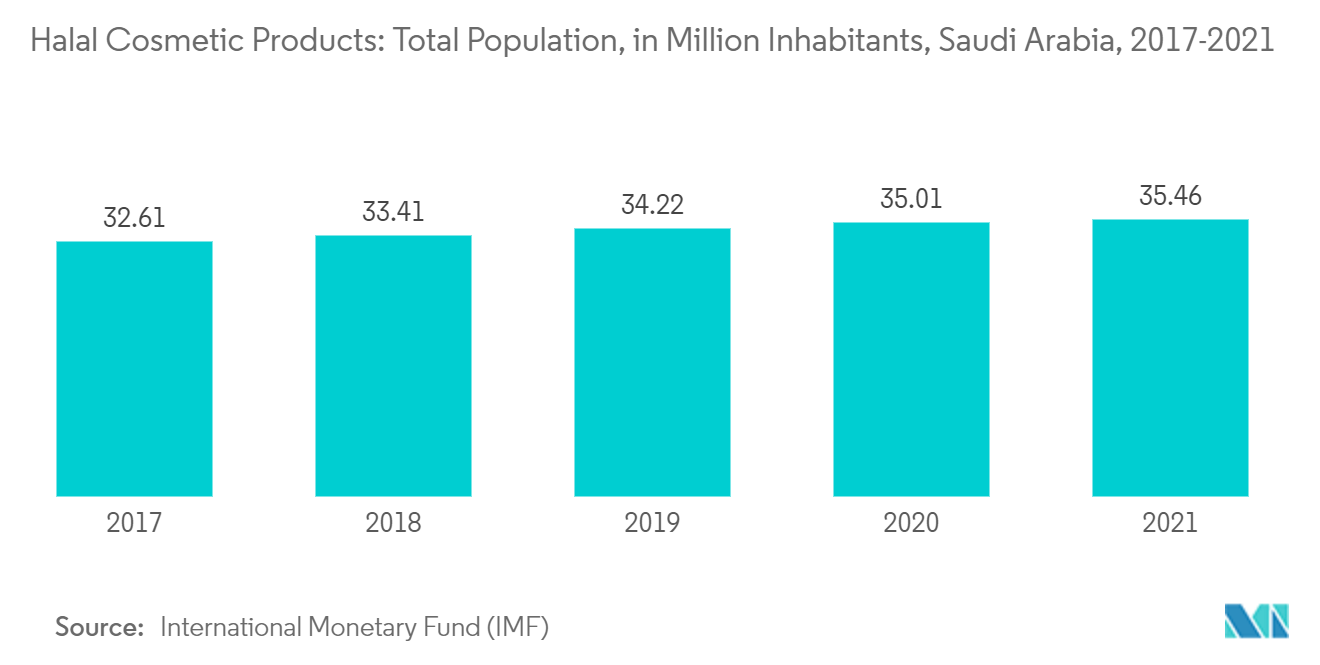
Burgeoning Demand for Cosmetics From Middle-East Region
Demand for cosmetic products in the Middle East Region is increasing rapidly, with the United States Emirates and Saudi Arabia being one of the largest emerging markets globally. This region has a large Muslim population, thus giving halal cosmetic products a lucrative opportunity for growth. Furthermore, Saudi Arabia has one of the prominent markets for cosmetics and fragrance products in the Middle East. Consumers in the country tend to spend substantially on their appearance, supplementing cosmetics growth. The high percentage of the Muslim population in the country has resulted in a rise in demand for halal cosmetics and fragrances. Such factors have allowed global brands and online retailers to expand their offerings to capture the demand. Owing to the demand for halal-certified products in the region, Saudi Arabian PIF (Public Investment Fund) launched its new company named Halal Products Development Company in October 2022. The company aims to manufacture personal care and cosmetic products locally in Saudi Arabia and to export halal-certified products across the world.
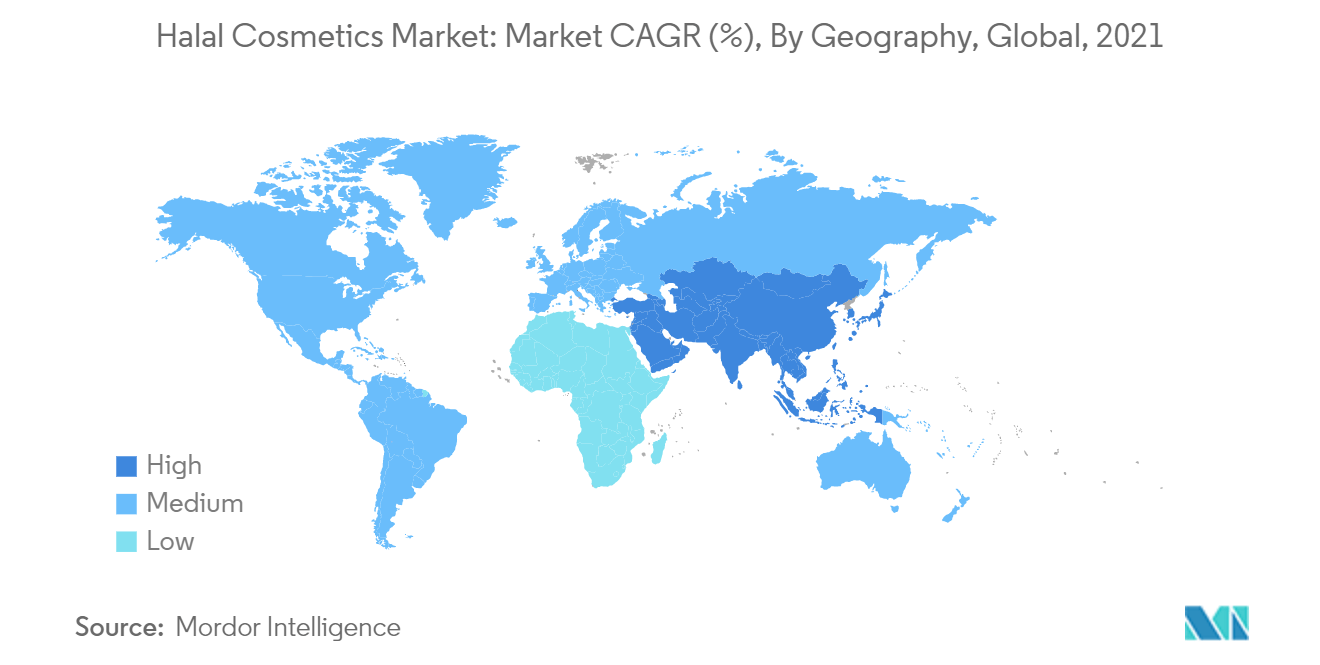
Halal Cosmetic Products Industry Overview
The global halal cosmetic products market is a highly competitive market, with the presence of various domestic and international players. Some players with a wide range of halal cosmetics products are Ecotrail Personal Care, IVY Beauty Corporation, The dUCk Group, Clara International Beauty Group, and INIKA Organic, among others. Manufacturers are focusing on leveraging opportunities posed by the market studied to expand their revenue base. Product launches, certifications by reputed and authentic organizations, and expansions in terms of geographical presence & product offerings were a few of the competitive strategies adopted by the manufacturers in the market.
Halal Cosmetic Products Market Leaders
-
INIKA Organic
-
IVY Beauty Corporation
-
Clara International Beauty Group
-
The dUCk Group
-
Ecotrail Personal Care (Iba Halal Care)
*Disclaimer: Major Players sorted in no particular order
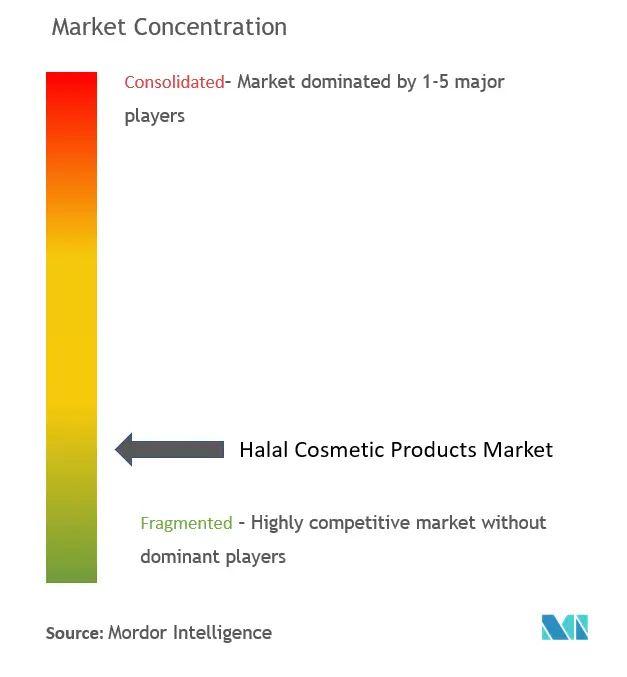
Halal Cosmetic Products Market News
- In November 2022, Iba Cosmetics partnered with Believe company based in Singapore. Believe company has invested USD 10 million to partner with Iba Cosmetics to distribute and expand their retail market space across operating countries such as Middle Eastern countries and European and South Asia countries.
- In April 2022, Inika Organic launched its new cosmetics collection named Pure with Purpose. The range of products included in the group is Lash & Brow Serum, Hydrating Toning Mist, Eyeshadow Quads, Brow Palette, and more. These products are claimed to be 100% natural, vegan-certified, halal-certified, and cruelty-free.
- In December 2021, The dUCK Group expanded its presence across Singapore by opening its new retail cosmetic store. The store is located a 1,800 square feet in Haji Lane, Singapore. The store retails its exclusive, newly launched collection and limited edition pieces in the store.
Halal Cosmetic Products Market Report - Table of Contents
1. INTRODUCTION
- 1.1 Study Deliverables and Study Assumptions
- 1.2 Scope of the Study
2. RESEARCH METHODOLOGY
3. EXECUTIVE SUMMARY
4. MARKET DYNAMICS
- 4.1 Market Drivers
- 4.2 Market Restraints
-
4.3 Porter's Five Forces Analysis
- 4.3.1 Threat of New Entrants
- 4.3.2 Bargaining Power of Buyers/Consumers
- 4.3.3 Bargaining Power of Suppliers
- 4.3.4 Threat of Substitute Products
- 4.3.5 Intensity of Competitive Rivalry
5. MARKET SEGMENTATION
-
5.1 Product Type
- 5.1.1 Skin Care
- 5.1.2 Hair Care
- 5.1.3 Color Cosmetics
- 5.1.4 Fragrances
-
5.2 Distribution Channel
- 5.2.1 Supermarkets/Hypermarkets
- 5.2.2 Specialty Stores
- 5.2.3 Convenience Stores
- 5.2.4 Online Retail Stores
- 5.2.5 Other Distribi
-
5.3 Geography
- 5.3.1 North America
- 5.3.1.1 United States
- 5.3.1.2 Canada
- 5.3.1.3 Mexico
- 5.3.1.4 Rest of North America
- 5.3.2 Europe
- 5.3.2.1 Germany
- 5.3.2.2 United Kingdom
- 5.3.2.3 France
- 5.3.2.4 Russia
- 5.3.2.5 Spain
- 5.3.2.6 Italy
- 5.3.2.7 Rest of Europe
- 5.3.3 Asia-Pacific
- 5.3.3.1 China
- 5.3.3.2 Japan
- 5.3.3.3 India
- 5.3.3.4 Australia
- 5.3.3.5 Rest of Asia-Pacific
- 5.3.4 South America
- 5.3.4.1 Brazil
- 5.3.4.2 Argentina
- 5.3.4.3 Rest of South America
- 5.3.5 Middle-East and Africa
- 5.3.5.1 South Africa
- 5.3.5.2 Saudi Arabia
- 5.3.5.3 Rest of Middle-East and Africa
6. COMPETITIVE LANDSCAPE
- 6.1 Strategies adopted by leading players
- 6.2 Market Share Analysis
-
6.3 Company Profiles
- 6.3.1 INIKA Organic
- 6.3.2 IVY Beauty Corporation
- 6.3.3 Clara International Beauty Group
- 6.3.4 Ecotrail Personal Care (Iba Halal Care)
- 6.3.5 The dUCk Group
- 6.3.6 INGLOT Cosmetics
- 6.3.7 Sampure Minerals
- 6.3.8 Halal Beauty Cosmetics
- 6.3.9 Talent Cosmetics Co. Ltd
- 6.3.10 Amara Halal Cosmetics
- *List Not Exhaustive
7. MARKET OPPORTUNITIES AND FUTURE TRENDS
** Subject To AvailablityHalal Cosmetic Products Industry Segmentation
Halal cosmetic products must not contain any of the following: alcohol, human parts, ingredients thereof, or animals prohibited for consumption by Muslims. The global halal cosmetic products market is segmented into product type, distribution channel, and geography. By product type, the market is segmented into skincare, haircare, color cosmetic, and fragrances. By distribution channel, the market is segmented into supermarkets/hypermarkets, specialty stores, convenience stores, online retail stores, and other distribution channels. The report analyzes emerging and established economies across the globe, comprising North America, Europe, Asia-Pacific, South America, and Middle East & Africa. For each segment, the market sizing and forecasts have been done based on value (in USD million).
| Product Type | Skin Care | |
| Hair Care | ||
| Color Cosmetics | ||
| Fragrances | ||
| Distribution Channel | Supermarkets/Hypermarkets | |
| Specialty Stores | ||
| Convenience Stores | ||
| Online Retail Stores | ||
| Other Distribi | ||
| Geography | North America | United States |
| Canada | ||
| Mexico | ||
| Rest of North America | ||
| Geography | Europe | Germany |
| United Kingdom | ||
| France | ||
| Russia | ||
| Spain | ||
| Italy | ||
| Rest of Europe | ||
| Geography | Asia-Pacific | China |
| Japan | ||
| India | ||
| Australia | ||
| Rest of Asia-Pacific | ||
| Geography | South America | Brazil |
| Argentina | ||
| Rest of South America | ||
| Geography | Middle-East and Africa | South Africa |
| Saudi Arabia | ||
| Rest of Middle-East and Africa |
Halal Cosmetic Products Market Research FAQs
How big is the Halal Cosmetic Products Market?
The Halal Cosmetic Products Market size is expected to reach USD 91.50 billion in 2024 and grow at a CAGR of 7.48% to reach USD 131.23 billion by 2029.
What is the current Halal Cosmetic Products Market size?
In 2024, the Halal Cosmetic Products Market size is expected to reach USD 91.50 billion.
Who are the key players in Halal Cosmetic Products Market?
INIKA Organic, IVY Beauty Corporation, Clara International Beauty Group, The dUCk Group and Ecotrail Personal Care (Iba Halal Care) are the major companies operating in the Halal Cosmetic Products Market.
Which is the fastest growing region in Halal Cosmetic Products Market?
Europe is estimated to grow at the highest CAGR over the forecast period (2024-2029).
Which region has the biggest share in Halal Cosmetic Products Market?
In 2024, the Middle East and Africa accounts for the largest market share in Halal Cosmetic Products Market.
What years does this Halal Cosmetic Products Market cover, and what was the market size in 2023?
In 2023, the Halal Cosmetic Products Market size was estimated at USD 85.13 billion. The report covers the Halal Cosmetic Products Market historical market size for years: 2018, 2019, 2020, 2021, 2022 and 2023. The report also forecasts the Halal Cosmetic Products Market size for years: 2024, 2025, 2026, 2027, 2028 and 2029.
Halal Cosmetic Products Industry Report
Statistics for the 2024 Halal Cosmetic Products market share, size and revenue growth rate, created by Mordor Intelligence™ Industry Reports. Halal Cosmetic Products analysis includes a market forecast outlook to 2029 and historical overview. Get a sample of this industry analysis as a free report PDF download.



